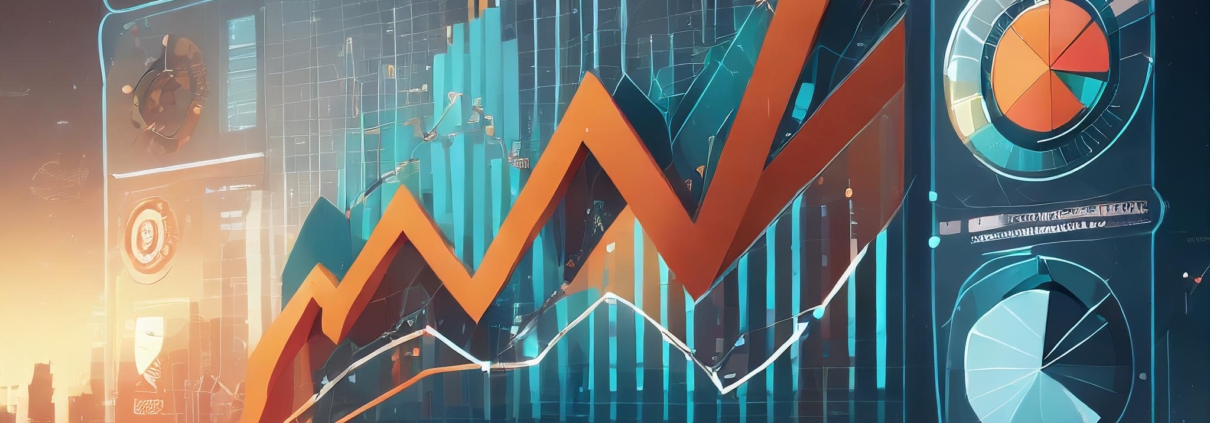AI Growth – What does this mean in figures?
AI Growth – What does this mean in figures?
Background
Everybody agrees that AI’s growth and influence will be huge. But what will AI’s growth be in concrete figures, and where will it happen? Whether it’s market-size projections or productivity enhancements, the figures below provide a comprehensive understanding of AI’s rapid evolution and potential to shape the future. Learn about the AI trends that will determine the state of technology, business, and society in the upcoming years.
AI’s market size is expected to reach $407 billion by 2027
The AI market is projected to reach a staggering $407 billion by 2027, experiencing substantial growth from its estimated $86.9 billion revenue in 2022.[1]
AI is estimated to contribute to a 21% net increase in the United States GDP by 2030
AI is expected to contribute a significant 21% net increase to the United States GDP by 2030, showcasing its impact on economic growth.[2]
Over 75% of consumers are concerned about misinformation from AI
A Forbes in-house survey on AI consumer sentiment shows AI is anticipated to add a substantial 21% net boost to the United States GDP by 2030, indicating its influence on economic growth. [3]
ChatGPT had 1 million users within the first five days of being available
ChatGPT’s remarkable adoption rate is evident as it garnered 1 million users within the first five days of its release.[2]
One in 10 cars will be self-driving by 2030
It is expected that 10% of vehicles will be driverless by 2030, as the global market of self-driving cars is forecasted to increase from 20.3 million in 2021 to 62.4 million.[1]
64% of businesses expect AI to increase productivity
A significant 64% of companies believe that artificial intelligence will help increase their overall productivity, as revealed in a Forbes Advisor survey. This demonstrates the growing confidence in AI’s potential to transform business operations.[3]
AI Adoption Statistics : AI Growth – What does this mean in figures?
Half of U.S. mobile users use voice search every day
Voice search is on the rise, with 50% of U.S. mobile users using it daily, according to UpCity. This trend showcases the growing prevalence of AI-powered voice assistants in everyday life.[4]
AI is expected to see an annual growth rate of 37.3% from 2023 to 2030
As reported by Grand View Research, AI continues to revolutionize various industries, with an expected annual growth rate of 37.3% between 2023 and 2030. This rapid growth emphasizes the increasing impact of AI technologies in the coming years.[5]
A quarter of companies are adopting AI because of labor shortages
As labor shortages become a pressing concern, 25% of companies are adopting AI to address this issue, according to an IBM report. AI helps businesses optimize operations and compensate for the lack of human resources.[6]
Chinese companies have had the highest adoption rate of AI
China leads in AI adoption, with 58% of companies deploying AI and 30% considering integration. In comparison, the United States has a lower adoption rate, with 25% of companies using AI and 43% exploring its potential applications.[6]
AI Workforce and Employment Impacts: AI Growth – What does this mean in figures?
77% are concerned that AI will cause job loss in the next year
A substantial 77% of people expressed their apprehension that AI could bring about job losses in the near future, indicating widespread concern about the potential impact of technology on employment opportunities.[7]
400 million workers could be displaced because of AI
As AI evolves, it could displace 400 million workers worldwide. A McKinsey report predicts that between 2016 and 2030, AI-related advancements may affect around 15% of the global workforce. [8]
Research estimates AI will create 97 million jobs
According to World Economic Forum research, AI is projected to create around 97 million new jobs, potentially countering workforce displacement concerns.[9]
Software engineers and data engineers are being recruited for AI support
As AI becomes more integrated into businesses, there is a growing demand for AI support roles. In 2022, 39% of companies reported hiring software engineers, and 35% hired data engineers for AI-related positions, according to a McKinsey report. [8]
The manufacturing industry is expected to see the most significant financial impact due to AI
An Accenture report forecasts that the manufacturing sector will reap the greatest financial benefit from AI adoption, with a gain of $3.8 trillion expected by 2035. AI has the potential to alter the sector’s economic impact drastically.[10]
AI Business Impacts: AI Growth – What does this mean in figures?
Nearly a quarter of business owners are concerned about AI affecting website traffic
A Forbes Advisor survey reveals that 24% of business owners express concern about AI’s potential impact on their website traffic, reflecting the uncertainties some businesses face regarding integrating AI into their operations.[3]
97% of business owners believe ChatGPT will help their business
According to Forbes Advisor, a staggering 97% of business owners believe that ChatGPT will benefit their businesses. One in three companies plan to use ChatGPT to create website content, while 44% aim to generate content in multiple languages.[3]
Over 60% of business owners believe AI will improve customer relationships
Forbes Advisor reports that 64% of business owners believe AI has the potential to improve customer relationships, indicating a positive outlook on the role of AI in enhancing client interactions.[3]
Over 60% of business owners say AI will increase productivity
Over 60% of business owners believe AI will increase productivity. Specifically, 64% state that AI would improve business productivity, and 42% believe it will streamline job processes.[3]
43% of businesses are concerned about technology dependence
43%of companies are concerned about technology dependence and an additional 35% worry about having the technical skills to use AI effectively. These concerns highlight the challenges that organizations face while adopting AI technologies.[3]
AI Trust and User Sentiment: AI Growth – What does this mean in figures?
The majority of consumers are concerned about businesses using AI
A significant majority of consumers express concern about businesses using AI. As AI plays a more prominent role in various industries, addressing consumer apprehensions will be crucial for companies.[7]
65% of consumers say they’ll still trust businesses who use AI
Despite concerns about AI usage, 65% of consumers still trust businesses that employ AI technology. This suggests that when businesses use AI responsibly and transparently, they can maintain consumer confidence and even harness AI’s potential to improve customer experiences.[7]
More than half believe AI will improve written content
Over half of respondents, 54%, believe that AI can improve written content, suggesting that AI-driven solutions such as ChatGPT have the potential to enhance text quality, creativity and efficiency in various content creation contexts.[7]
Most Popular AI Uses in 2024
The most popular AI uses include responding to messages, answering financial questions, planning travel itineraries and crafting social media posts as its versatility transforms everyday tasks.[7]
Sources
- Marketsandmarkets
- Statista
- Forbes Advisor. How Businesses Are Using Artificial Intelligence In 2023.
- UpCity
- GrandViewResearch
- IBM
- Forbes Advisor. Over 75% Of Consumers Are Concerned About Misinformation From Artificial Intelligence.
- McKinsey & Company
- WeForum
- Accenture



